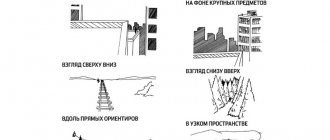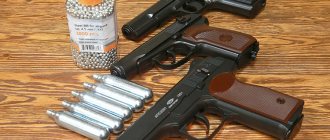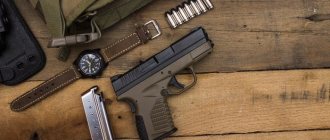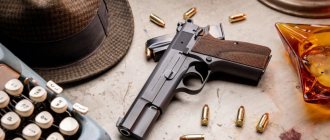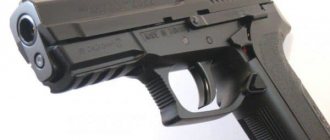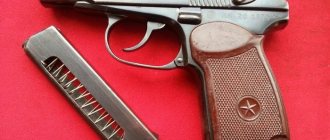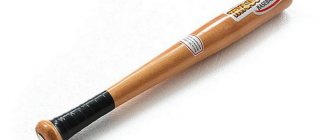What is a traumatic weapon from the point of view of the law?
According to the current legislation of the Russian Federation, civilian models of pistols of various designs intended for self-defense of citizens are considered traumatic or limited-damage firearms. A traumatic weapon may have the following distinctive characteristics:
- Ammunition for traumatic weapons uses a rubber bullet as a striking element, which is not capable of causing serious injuries. Thus, OOOP is designed to temporarily incapacitate the attacker, allowing the defender to escape the scene of the attack.
- The use of a traumatic pistol is permitted only for self-defense purposes. It is for this purpose that various teaching materials have been developed and are available at training centers for shooting such weapons.
- The muzzle energy of traumatic ammunition is limited to 91 Joules - sufficient to cause severe pain and temporarily incapacitate the enemy, but not enough to cause serious damage.
- The magazine capacity of a traumatic pistol is limited to ten charges.
- OOOP should not be able to use solid-state ammunition and conduct automatic fire.
Self-defense weapons can be carried with you and used if necessary only if you have the necessary permits - a license to purchase and carry weapons.
How to obtain permission to carry a traumatic weapon
A person over 21 years of age can obtain a license.
The procedure for obtaining a license is as follows.
- Pass a medical examination. You must contact a public hospital that is authorized to issue certificates in form 046-1 . You will need to make an appointment with a therapist, psychiatrist, narcologist and ophthalmologist. Passing a medical examination requires payment. The validity period of the completed certificate is 1 year.
- Take a paid training course when using weapons. It is necessary to enroll in an educational institution that is authorized to conduct such exams - information about such institutions can be found in the Department of Internal Affairs. On average, the course costs 5-7 thousand rubles , its duration is 12-15 hours. The course is devoted to how to buy a weapon, use it, and what penalties you may face for carrying a weapon without a license. At the end of the course there are practical exercises.
- Send an application to the licensing department of the police at your place of residence.
The application will need to include the following information:
- personal information about the applicant: full name, date of birth, residential address;
- purpose of purchasing a weapon;
- weapons storage location;
- date of compilation, signature.
Application for a permit to store and carry firearms.docx
The following documents are attached to the application:
- photocopy of passport;
- photo 3x4 format;
- a receipt confirming payment of the state duty (its amount is 100 rubles);
- certificate establishing no criminal record.
The application is reviewed within 10-14 days. During this period, the applicant will be informed of the need to come to the same department to obtain a license. Its validity period is 5 years.
In order to renew the permit for another 5 years, you must contact the LRO 3 months before its expiration date. If you go to the institution later, the staff will refuse to renew your permit.
The package of documents is similar, but there is no need to take the training course again.
Who can use traumatic weapons
According to the current legislation of the Russian Federation, permission to carry and use weapons of limited destruction can be obtained upon reaching the age of full majority - 21 years. In this case, a candidate for obtaining permits must meet certain parameters specified in the legislation. Carrying a traumatic weapon, as well as its use, is permitted for the following categories of citizens:
- Serving in the armed forces, the Ministry of Internal Affairs and the Ministry of Justice of Russia.
- Civilians who consider it necessary to protect their lives and health by using traumatic pistols.
- Athletes involved in practical shooting with firearms, as well as instructors.
- Representatives of civil professions involved in protecting themselves or their property from predatory animals (for example, livestock grazing or forestry employees)
- Citizens who are under the state witness protection program.
How to shoot from a wound so as not to become a criminal
The practice of using trauma often shows through life examples that the use of weapons in self-defense can result in trouble for the person defending himself.
Since the appearance of traumatic weapons in the Russian Federation, the use of traumatic weapons has been classified mainly as “hooliganism with the use of weapons of a limited type.” Trying to prove that a weapon was used only for defense and not for attack is very difficult.
Such cruel measures are associated not simply with some biased attitude of law enforcement agencies towards this type of weapon, but due to frequent misuse. Many people use traumatic weapons not as a means of defense, but as a means of showdown. Someone said something offensive to someone, parked their car in the wrong place, or even just looked the wrong way. Everyone immediately jumps to the use of traumatic weapons.
According to law enforcement officers, such weapons should be given to a person only after full confirmation that the person is mentally healthy and adequate.
Where you can't shoot
It is strictly forbidden to shoot at the following places because getting caught in them can lead to serious injury, disability and death.
Places you shouldn't shoot at;
- The entire head area;
- Women in the chest;
- In the groin area;
- In the cervical area.
Requirements for wearing and using trauma equipment
In order to avoid administrative or criminal liability, it is necessary to comply with the rules of carrying weapons of limited destruction. Thus, the law prohibits:
- Make changes to the design of weapons aimed at increasing the power of the shot, as well as for the use of solid ammunition;
- Carry the pistol loaded (the magazine may be in the grip, but the chamber must remain empty and the safety engaged);
- Carry more than two traumatic pistols with you at the same time;
- Carry a traumatic pistol in crowded places or public transport;
- It is strictly prohibited to carry weapons of limited destruction while under the influence of alcohol or drugs, as well as under the influence of psychotropic drugs;
Self-defense weapons should always be in a holster, without a cartridge in the chamber and with the safety on. There is no need to think about whether a license is needed - the owner must always have identification documents with him, as well as all permits for the right to carry and use firearms of limited destruction.
Trauma shooting: self-defense or attack?
In Anapa, investigators are interrogating a young man who opened fire with a traumatic pistol in a school yard. As a result, one of the students ended up in intensive care. It must be said that in the reports of incidents over the past week, this is not the only case where they tried to resolve conflicts with the help of trauma. According to statistics, more than a hundred people have died from rubber bullets over the past five years. In the meantime, weapons for self-defense may appear on the open market, but with live ammunition.
The day before there was a shooting at one of the village schools. A ninth grade student was shot in the forehead. “An ordinary ordinary situation. The children went out for recess. The teacher, who came out to remind the children that classes were coming soon, heard a bang, and also did not understand that it was a shot. We recently celebrated New Year here, you understand, there was shooting,” said school director Svetlana Amarina.
A twenty-year-old young man shot a ninth-grader. He fired rubber bullets from a traumatic pistol. A village resident came to school with a weapon to talk to his girlfriend’s abuser. After the standard “let’s go, let’s go out”, already behind the school, Ruslan took out a pistol and shot Vadim twice in the legs. When he ran, he pulled the trigger again. The victim was taken to the hospital with a gunshot wound to the head, underwent surgery, and was transferred to intensive care. The shooter was taken to the police, where he said that he lost control because he could not cope with the feeling of revenge for his girlfriend.
Shots were fired in one of the residential areas in the south-east of Moscow last Sunday. The courier decided to relieve himself at the entrance of the house after delivering the order. A resident of a neighboring apartment saw this and reprimanded the young man. The courier responded to the claims, pulled out an air pistol and opened fire. Alexander hid behind the door of the apartment, took a traumatic pistol from home and a shootout began. The story, according to neighbors, received an even more unexpected continuation.
“He started shooting at my neighbor Alexander. They ran out into the street, where the courier’s mother was standing, who was also carrying a gun. Texas is resting,” say eyewitnesses of the incident.
The mother supported her son. As a result, all participants in the shootout ended up in the hospital with various wounds. The police are identifying the culprits. Reports of such shootings appear regularly. Over the past five years, about a hundred people have died as a result of the use of traumatic weapons. But recently there have been more and more murders and injuries from rubber bullets. Even sellers say that many owners of weapons of limited destruction do not know how to use them.
“We need to remove these weapons from the market. As long as there is a given name and definition associated with this weapon, people will relax, and while shooting, he will always remember that this is a weapon of limited destruction. Since it’s limited, it means it can be used to its fullest,” says Anatoly Drapkin, commercial director of the Arms Group weapons store. At the same time, market participants are seeking permission to use weapons with live ammunition for self-defense. They say that statistics in Eastern European countries indicate that the free circulation of such pistols reduces the crime rate. But the heads of law enforcement agencies are against such weapons reform. According to the deputy head of the Main Directorate for Ensuring the Protection of Public Order of the Ministry of Internal Affairs of Russia, “traumatics” are quite enough for self-defense, but it is necessary to adjust the legislation.
“Many people argue and debate: what kind of test shooting of such weapons can there be? The bullet is rubber, there will be nothing left there. Yes, here we can agree with something in relation to the bullet, but the cartridge case also allows us to identify it with traces and establish the owner. This norm also does not exist today. It could work,” says Leonid Vedenov, deputy head of the GUOOOP of the Russian Ministry of Internal Affairs.
According to many experts, firearms with live ammunition - if they are freely sold under license - will be used more often as a means of attack.
Central street of Vladikavkaz. Near one of the cars is what remains of the festive banquet. Here a young man celebrated the birth of his son in the company of friends. But suddenly the acquaintances quarreled, the evening ended with shooting, and the young father was killed. Such incidents have a much stronger impression on experts and legislators than European statistics.
In what cases can traumatic weapons be used?
A traumatic pistol is allowed to be used only in certain cases - when the life and health of the owner or his loved ones, as well as his property, are in real danger.
The main goal of OOOP is to prevent a serious offense, and not to create it, so the defender must clearly understand the line where he can shoot - between necessary self-defense and an attempt on life and health.
It would be appropriate to use a traumatic pistol against an armed aggressor who poses a real threat to the owner of a weapon of limited destruction. At the same time, according to the legislation of the Russian Federation, the shooter must first warn the aggressor, and also, if possible, fire a warning shot in the air. Only after this is it allowed to open fire on the target at permissible firing distances.
From laws to real application
The purpose of traumatic weapons is defined as a means to protect life and health, as well as the health of their loved ones. In practice, it turns out that the use of traumatic weapons in most cases results in serious trouble for the owner.
Formally, a criminal case should be initiated on the basis of murder or infliction of significant injury. But for law enforcement agencies, any use of weapons is associated with hooliganism, so it is quite difficult to prove the legality of using traumatic weapons.
Unfortunately, there is no single step-by-step instruction for using OOO. It can only be developed independently, referring to the opinion of experts. Modern technology makes it easy to record audio or video. When a conflict is brewing, it is recommended to turn on the voice recorder or camera. If there are several attackers, their testimony will be more powerful than yours.
In this case, we can only rely on stationary video cameras installed in stores, entertainment centers, and entrances. It is necessary to record on camera the fact that you loudly warned the hooligans about your intention to use weapons, and also fired one shot in the air. In real cases, it is almost impossible to carry out such preventive measures, which does not play into the hands of the gun owner.
The moment when the aimed shot was fired will play an important role. No matter how strange it may sound, the least problems will arise if you had to defend yourself after the attackers began to beat you. Only in such a situation are actions regarded as self-defense. If the enemy does not use weapons and tries to break into an apartment or car, and also grabs you, then open fire will be classified as exceeding the necessary self-defense measures. It is somewhat easier to comply with the law when the attacker swings a stick or other object. You can safely shoot at the moment of swing.
The use of trauma against women, children or the disabled is almost always illegal. The exception is cases of attack by an armed group of teenagers.
Shots and distances
Self-defense weapons are designed to cause slight harm to the health of the attacker when shooting at soft tissues. As a rule, the zone of effective safe use of firearms with limited destruction is considered to be a distance of three to six meters. Beyond this distance, a hit may have no effect on the attacker, but closer than three meters it poses a real threat to life or health.
At effective safe shooting distances, a rubber bullet can hit muscle tissue to a depth of one and a half centimeters, causing superficial or penetrating wounds of soft tissue, depending on the density of the aggressor’s clothing. That is why it is necessary to shoot only at permitted places, without causing serious damage.
Civilian shooter training: Working with a traumatic pistol
Today we will talk about a recently discussed topic: training and exercises for the civilian shooter . Let's immediately decide on geography. We will talk about urban self-defense . If only because outside the city a pistol is not the main weapon. There are shotguns and carbines for that, but if something happens, people will remember the last thing about a pistol.
The main working distances for training are 1-3-5 meters. Why these particular distances? urban self-defense hardly suggests more than 5 meters Let me remind you that we are talking about a civilian shooter , not a bodyguard. That is, at a distance of over 10 meters it is difficult to imagine self-defense in the city. It is clear that it would be good to be able to shoot at any working distance, but, in fact, if we are talking about defensive shooting, then it is unlikely that you will have to shoot further than 5 meters. Especially considering that we have traumatic pistols self-defense weapons , which most people do not take seriously. That is, it is not so unlikely that when they see that a person is armed, they will try to push him with arguments:
- What will you do to me with your rubber band?
As a result, you will have to shoot in a situation where the distance is quickly closing. In the case of country life, the only people willing to use a shotgun are those who are completely alcoholic.
Here, by the way, immediately lies another point, which for some reason is completely ignored by most specialists in civilian shooting training . The fact is that shooting from a static position is harmful and dangerous primarily for the shooter himself. For example, when shooting from a pistol at short distances, no one guarantees that the enemy will not have time to reach you even from a distance of 5 meters. And if he managed to get there, then even with a couple of bullet wounds he will have time, for example, to intensively stab you with a knife. And then there’s the question: who will suffer more in the end? An attacker with three neat holes or a defender with five lacerations from a knife, or a split skull from a blow from a rebar. In addition, in a state of shock from wounds, the attacker can simply hang on the shooter and stupidly stab him to death with a rusty nail. The fact that the attacker himself will die in a couple of minutes will be of little comfort to the deceased.
Therefore, a civilian shooter must learn to shoot first of all while moving.
Well, okay, the main points have been clarified, now about the boring shooting.
The content of the article
Basic exercises
Static shooting
Practicing accurate shooting from a standing position. That is, the primary task is simply to teach a person to shoot accurately.
The next stage is adding a standard for time. Moreover, it is more logical to take the scheme used in IDPA , when the holster with a weapon is hidden under clothing.
- Single shot practice on one target.
- Practicing a paired shot at one target.
- Practicing a series of shots at one target.
All this is done for a while. It is difficult to accurately indicate time standards “by eye”. But I insist on 1-1.5 seconds for the first shot. For each next shot, it is logical to add 0.3-0.5 seconds. I remind you that you need to hit the target accurately. But the time frame, of course, requires consideration in more detail and in practice.
Shooting at specific points on a target. That is, practicing targeted fire with different tasks: destruction, suppression. Working distances: 1-3-5 meters. Shooting is carried out from a static position.
Shooting at a group of targets, with shooting practice for destruction. Working distances: 1-3-5 meters. Shooting from a static position. Shooting is carried out at 2 or 3 targets (of course, the number of targets changes as the shooter’s level increases). At the initial stage, only hitting targets is practiced. After the shooter confidently hits all targets, all exercises begin to be performed against time.
In the process of a shooter working on a group of targets, it is necessary to instill the skill of correctly assessing the situation. That is, in its simplest form - first hitting the closest target, and then - according to the degree of distance from oneself.
In the same way, after confidently practicing shooting for destruction , we work on shooting “for suppression” according to a similar scheme.
After the shooter begins to confidently hit targets from a static position, we begin shooting in motion.
Dynamic shooting
First of all, the shooter must be trained to operate the pistol while moving. That is, we are not talking about shooting, but about “hollowing” the weapon in motion . The primary movements are quite simple: a “shot” with a step back, a step to the side, as well as a step back and to the side (at an angle from the enemy).
When mastering the skill of aiming and firing a conventional shot in motion , the shooter begins to train with a loaded weapon.
The main task at this stage is to acquire the skill of hitting targets (from one to three) while moving. Movement, in this case, means moving either one or several steps away from the enemy while taking a defensive stance with the weapon .
When confidently hitting targets in normal mode, facing the target, the shooter begins to work on the “fuss” principle. That is, when the shooter has his back to the targets, and until he turns to face them, he does not know their location and distance to them. By constantly changing the position of the targets relative to the shooter, the situation is tested in basic stress test . In the future, the stress test component of training must be supplemented with acoustic accompaniment appropriate to the situation being worked out.
It is also necessary to practice these shooting exercises in conditions of insufficient and excessive lighting.
Again, do not forget that during the training process not only the tasks of destruction, but also suppression are practiced.
Add-ons
Practicing the start of opening fire should be carried out not only from the position of the formed stance, but also from three additional positions:
- First shot from the hip (almost immediately after removing the pistol from the holster)
- First/second shot from the chest.
- The first/second/third shot from a practically formed stance position.
In this way, the shooter gains the skill of firing and hitting a target without bringing the weapon to the aiming line. This gives him an advantage in the speed of hitting targets.
When preparing a civilian shooter, should be paid to the following points:
- Rack. Unlike combat and sports stances, a civilian shooter must first of all be able to confidently operate a weapon with one hand (depending on personal physical characteristics). The development of ambidexterity in this case is not a fundamental factor.
- Methods of resisting close contact with an attacker in order to keep him at a distance from you while drawing a weapon and firing.
- Ways to counter the attacker's seizure of a civilian shooter's . In this case, this may include elements of practical self-defense, but without “fanaticism.” That is, the shooter’s task in such a situation is to suppress an attempt to seize the weapon, break the distance and open fire. This type of training is performed using airsoft or paintball weapons, the weight and dimensions of which are as close as possible to the weapon the shooter owns.
- High-speed reloading of weapons and quick troubleshooting of personal weapons (misalignment). In this situation, it is fundamentally important that the person is able to make at least one quick magazine change. Because if it comes to changing the magazine a second time, and the problem is not solved, then either they did not teach how to shoot, or the shooter incorrectly assessed the situation. In short, he’s most likely fucked.
civilian shooter training course must include training in the following variations:
- Firefight in a confined space: Entrance, Room, Corridor.
- Firefight in an extremely confined space: Elevator, Car.
In all situations, you can use both targets and living “opponents,” but in this case, naturally, with the use of airsoft and paintball weapons.
These moments of training have not only (and not so much) a practical effect for improving the skill of the shooter, but for increasing psychological stability in a stressful situation.
Also, during the training process, equipment is selected for everyday wear, ensuring maximum comfort both in wearing and using weapons. In fact, this point is very important, because it’s impossible to count how many people were killed due to incorrectly chosen equipment and underestimating its significance.
It is imperative to consider the issue related to protecting your own home. The main point here is the choice of methods and means of storing weapons so that, if necessary, they are quickly accessible and ready for use. Fortunately, there are now a lot of such options, for example, take safes that open by voice command, fingerprint, contactless or contact key card.
Honestly, it seems to me that a well-conducted course in this or a similar program will prepare a civilian shooter for a self-defense situation and help minimize stress during and after the incident. Well, it will allow him to act as efficiently as possible in the process.
PS Let me remind you that in this case we are talking about pistols and traumatic weapons . Carbines and other long-barreled weapons must be considered separately.
Where you can't shoot
According to current legislation, it is prohibited to shoot at particularly vulnerable places - the head (specifically, the back of the head, temporal part and face), neck, chest (applies only to women), as well as the groin and the location of vital organs. Thus, it is allowed to fire only at soft tissues of the body, for example:
- Stomach
- Hips and legs
- Forearms
- Gluteal muscles
- Back
At the same time, it is not recommended to shoot at distances closer than three meters, in order to avoid serious injury.
What to do after using a weapon
After the owner was forced to use a traumatic pistol, it is necessary to take a number of actions, in accordance with current legislation. The procedure is as follows:
- It is mandatory to notify law enforcement agencies about what has happened, and it is best to call police officers to the scene of the incident.
- Take a photograph of the scene, making sure to indicate the location where the attacker was located, as well as the location from which the shot was fired. In addition, it is necessary to photograph the extracted cartridge case (in the case of weapons that maximally imitate combat samples).
- Call an ambulance (if the attacker remained at the crime scene due to injury caused by the shot).
- Detain witnesses, if any, until law enforcement officers arrive.
All these actions are intended to maximally “whiten” the defender in the eyes of law enforcement agencies. In the opposite case, the person defending himself may be held accountable, even to the point of attack (depending on the imagination of the victim of the shot and witnesses), and this may entail prosecution under several articles of the Criminal Code of the Russian Federation.
What is the permissible limit of self-defense
The permissible limit of self-defense, or necessary defense (according to the law) is a set of actions aimed at eliminating the threat to the life or health of the defender. That is, until there is a real threat to your life or health - the aggressor is not trying to hit or start a fight, or does not demonstrate the intention to attack with some kind of weapon in his hands, the use of self-defense weapons is illegal. Accordingly, the use of a traumatic weapon against a threat can be regarded as exceeding the limits of necessary self-defense.
If the situation allows it, it is recommended to videotape the conflict on a mobile phone or try to bring the conflict under the lenses of CCTV cameras, fortunately there are a lot of them now. This will help you prove your case during proceedings with law enforcement agencies.
To put it simply, the limits of necessary self-defense are not violated if the attacker was not harmed more than could have been inflicted on the defender. And the best thing is to invite a lawyer during the proceedings and testify only in his presence.
Where can you shoot a traumatic pistol?
OOOP is intended for self-defense and official use by representatives of security organizations. Traumatic weapons are divided into two types: civilian and service. Citizens can only buy LLC models permitted for free sale.
Before purchasing a traumatic pistol, you must pass a medical examination, learn the rules of safe handling of weapons (at DOSAAF or NCOU DPO), obtain a license (at the Central Labor Inspectorate of the Ministry of Internal Affairs or LRO OVD), pay a state fee (2000+500 rubles), buy a safe for storing the traumatic pistol.
Citizens can fire their weapons only if there is a real threat to their life, health, or property. You can use the trauma on the street or on the territory of your own home (cottage, land). Shooting in public places and transport is prohibited.
Slightly different rules for handling OOOP for security guards. Security company employees can shoot in public places (cafes, restaurants) while performing their professional duties. It is forbidden to use trauma unless absolutely necessary.
Punishment for exceeding the limits of permissible self-defense
Exceeding the limits of permissible self-defense implies that shooting from a traumatic pistol or revolver caused serious bodily harm to the attacker, and also if the shooter unintentionally killed the attacker. The criminal law of the Russian Federation is imperfect, and exceeding the limits of self-defense, due to the lack of specific legislative norms on the term “self-defense,” the defendant may be charged with serious crimes - for example, an attack on the life of another person.
Responsibility for exceeding the limits of necessary self-defense is established by Articles 108 and 114 of the Criminal Code of the Russian Federation.
Fatal wounds
If it is proven that the owner of the weapon deliberately aimed at the attacker’s head, then there can be no talk of any self-defense. These actions will be regarded as intent, even if the injury was caused by accident. That is why, when choosing a trauma device, accuracy is considered the determining parameter. The main task is not to hit the temple, eyes, neck.
Traumatic weapons have a very deceptive property. If a person may not even feel pain when a bullet hits parts of the body covered by clothing, then a shot in the temple or eye will most likely be fatal. It is for these reasons that the government decided to equate traumatic weapons with firearms, introducing a number of restrictive measures.
Tragic consequences can also occur if you are wounded in the stomach or even in the leg. A rubber ball, which is capable of entering a couple of centimeters into the body, can easily break an artery, and a person will die from blood loss. The most unpleasant thing is that it is difficult to predict the consequences of a shot from a trauma weapon. For the same model of pistol or revolver, cartridges with a wide range of energy are produced, and, as is known, the impact characteristics of the bullet depend on it.
